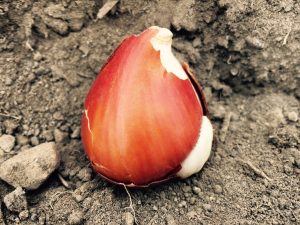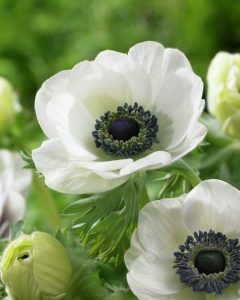By Trilby Becker
Greetings flower and nature lovers! Last I left you I was wrapping up the summer harvest and getting ready to plant anemones, ranunculus, and tulips for spring blooms. Fall planting got off to a very late start because of the unseasonably warm weather. By mid-November I decided it was now or never, and was planting in the hoop house in a tank top. The anemones and ranunculus are fairly slow-growing and cold tolerant, but I needed to delay the tulips as much as possible because they are quick starters and would get nipped in the bud if they emerged and then got hit with a cold snap.

Tulip bulb.
Did you know that what many people think of as “bulbs” is a category that actually includes bulbs, corms, tubers, tuberous roots, and rhizomes? Here’s a quick primer:
- Bulbs: Tulips are true bulbs, and like onions have a protective papery skin called a tunicate. A true bulb has a basal plate at the base where roots grow, and one miniature daughter bulb that will eventually produce a flower of her own. Bulbs are made of layers and have a perfect little flower at their center just waiting to emerge—fascinating! Perennial bulbs like tulips add inner layers every year as the energy from the outer layers is used up to grow the flower.
- Corms: Anemones and ranunculus are corms. They all also have a tunic, but it is hard and protects a solid mass of stem tissue underneath. When the energy inside the corm is used up, new corms will form.
- Tubers: Begonias have tubers. Tubers lack tunics and have numerous “eyes” which are the growth points (like potatoes).
- Tuberous roots: Dahlias have tuberous roots. They resemble tubers but grow in clusters and have only one growth point: a woody stem segment that must be planted facing up.
- Rhizomes: Lilly of the valley have rhizomes, which are horizontal underground stems that put out roots and shoots at intervals, spreading and eventually filling in an area.

Galiliee panda anemone.
Whether bulb, corm, or another type, the planting process is similar. I chose:
- 500 Galilee panda anemones, an elegant flower in solid white with a black eye. They are supposedly great producers and able to withstand the slip-ups of a slightly careless gardener.
- 500 renown unique tulips, which are gorgeous ruffled doubles in coral, pink, and green stripes from Dutch Grown Bulbs. Ben, the owner, also gifted me a hundred extra bulbs in ten different varieties. By the time I determined it was cool enough to plant them, a few had started to mold, and dear Ben promptly sent me another 165 bulbs on the house!
- For the ranunculus I went with La Belle series, 250 pastel and 250 vivid color mixes, from Gloeckner. The ranunculus corms look like little octopuses and are quite delicate. I was warned to only work with them after I had built up some confidence with the forgiving anemones, but ranunculus are so beautiful I decided to throw caution to the wind and give them a try.
Five hundred each isn’t as much as it sounds: all 1,800 bulbs and corms only filled two beds of a 30×90-foot hoop house.

A ranunculus corm after soaking.
On to the planting. First I had to soak the corms for several hours in cool water with an aerator to wake them up. I covered the anemones and ranunculus with plastic mulch from Flora Flow that has two lines of drip tape inside of it and pre-punched holes to save time weeding and watering later. I felt a bit indulgent using the plastic and got some disapproving looks from my husband who has vowed never to buy the stuff. But I was following the advice of a seasoned grower, and with two young kids and a job, who has time to weed?
 The tulips are best planted in trenches about six inches deep and two inches apart, four trenches per three-foot bed. It felt pretty awesome swinging the pickaxe to dig the beds. My four-year-old son Silas begged me to have a go, so I handed it over and he promptly clocked himself with it. I felt terrible; what was I thinking? But we had a very controlled lesson afterward and now he has gained some healthy respect for both the pickaxe and his mother.
The tulips are best planted in trenches about six inches deep and two inches apart, four trenches per three-foot bed. It felt pretty awesome swinging the pickaxe to dig the beds. My four-year-old son Silas begged me to have a go, so I handed it over and he promptly clocked himself with it. I felt terrible; what was I thinking? But we had a very controlled lesson afterward and now he has gained some healthy respect for both the pickaxe and his mother.
I’ll be back in the early spring with stories and pictures (fingers crossed) of lovely flowers to share! Happy winter!
Trilby Becker is a Legacy volunteer who photo-monitors protected properties and, through guest blog posts like this one, contributes her perspective on understanding and being in touch with nature on a daily basis.

 RSS Feed
RSS Feed
Pingback: Spring bursts forth in a riot of color | Legacy Land Conservancy | Ann Arbor, MI